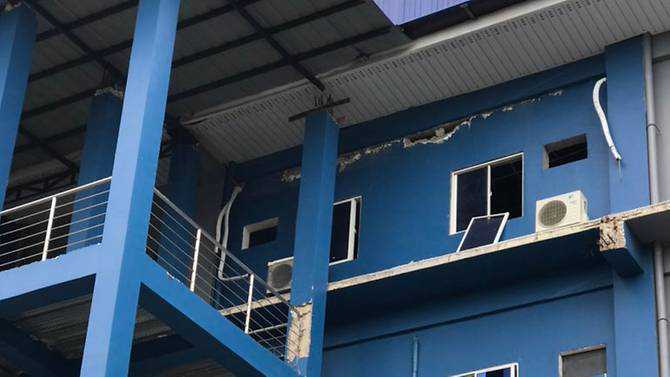Child killed as quake strikes southern Philippines
16 December, 2019

A powerful earthquake hit the southern Philippine island of Mindanao on Sunday (Dec 15), killing a child and damaging buildings in an area still recovering from a string of deadly quakes in October.
Police said a rescue operation had been launched at a heavily damaged market building near the 6.8 magnitude quake's epicentre, which is about 90km from the major city of Davao.
Patients were evacuated from hospitals as a precaution and nervous crowds massed outside shopping malls after the jolt and a series of smaller, but strong aftershocks.
People rushed from homes and restaurants set swaying by the strong jolt, and the Philippine Institue of Volcanology and Seismology said damage and aftershocks could be expected.
Two strong aftershocks of magnitude 5 and 5.7 centred north of General Santos City was recorded after the main tremor.
Anthony Allada, public information officer of Magsaysay Town in Davao del Sur province, near the epicentre, said 14 people were injured but none seriously. Roads and buildings, including the local government office, were damaged and power was out in the town, he said.
"We don’t know what to do anymore. Do we respond first or attend to our families first?”, Allada told DZMM radio.
Vincent Fernandez, the mayor of Matanao town in the southern Philippines, told local radio that a six-year-old girl had died after a wall collapsed on her during the quake.
He said the extent of the damage was not yet clear but authorities needed food, water and tarpaulins and blankets to help residents.
DZMM also reported that power was out in General Santos City, where patients at a local hospital were being evacuated.
Police said a rescue operation had been launched at a heavily damaged market building near the 6.8 magnitude quake's epicentre.
Patients were evacuated from hospitals as a precaution and nervous crowds massed outside shopping malls after the powerful jolt and a series of smaller, but strong aftershocks.
"We can no longer use our office because the walls cracked and the stairs collapsed," local police spokeswoman Lea Orbuda told AFP. "The power is off and the water taps are dry."
She added that at least 24 people had been taken to the hospital, but was not aware of any reports of deaths as search operations continued.
President Rodrigo Duterte, who is from Davao, was in the city when the quake struck.
“He is ok. He and his daughter Kitty were in their house when the quake struck," presidential spokesman Salvador Panelo said. "First Lady Honeylet was on her way home when the ground trembled. She said her car was swaying. She is unhurt.”
Video footage of the latest quake posted by users on Twitter showed overhead electrical wires swaying and erupting in a shower of sparks. Another video showed water sloshing out of a residential swimming pool.
One picture said to be from Padada, close to the epicentre in the province of Davao del Sur, showed a building collapsed onto a car. Reuters could not immediately verify the images.
The Philippines suffers regular tremors as part of the Pacific "Ring of Fire", an arc of intense seismic activity that stretches from Japan through Southeast Asia and across the Pacific basin.
Three quakes above 6.0 magnitude hit roughly the same area of Mindanao in a matter of weeks in October, killing some two dozen people and heavily damaging office buildings, schools and apartments.
Tens of thousands of people were forced into shelters by the string of tremors, the government said, either because their homes were damaged or they were too afraid to return.
Most of the deaths in October were due to collapsing walls and falling debris, including a teenage boy who was crushed by a falling wall as he tried to escape his school.
However, other fatalities were attributed to rock and landslides unleashed by the violent shaking that injured at least 400 people.
In hard-hit areas where aid took some time to arrive some villagers staying under tents near a highway begged for help from passing motorists, carrying placards asking for food and water.
In the wake of the tremors, rescuers went from town to town looking for casualties but also urging families to leave homes endangered by landslides, while several residents trapped in mountainous villages had been airlifted to safety.
The Philippines has been hit by very powerful earthquakes in recent decades, including a 7.8 magnitude that struck the northern resort town of Baguio in 1990.
That tremor toppled tall multi-story buildings and hotels, killing some 1,200 people.
There were no immediate reports of damage, but quakes of such magnitude can damage buildings.
The same region was shaken by three quakes in October and one in November, one which killed at least five people.
Video footage posted on Twitter by users to portray the impact of the quake showed overhead electrical wires swaying and erupting in a shower of sparks. Another video showed water sloshing out of a residential swimming pool. Reuters could not immediately verify the videos.
The Philippines sits on the geologically active Pacific Ring of Fire and experiences frequent tremors.
Source:
TAG(s):
